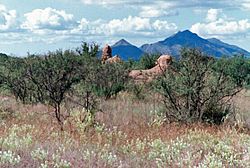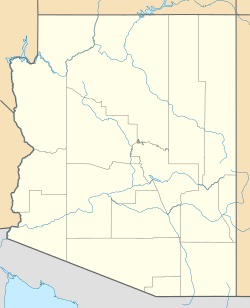Mission Los Santos Ángeles de Guevavi facts for kids

The ruins of the mission church of Los Santos Ángeles de Guevavi beneath the backdrop of San Cayetano Mountain and the Sierra Santa Rita.
|
|
| Location | near Tumacácori, Arizona |
|---|---|
| Name as founded | La Misión de San Gabriel de Guevavi |
| English translation | The Mission of Saint Gabriel of the Big Spring |
| Patron | Saint Gabriel |
| Founding date | 1701 |
| Founding priest(s) | Father Eusebio Francisco Kino Father Salvatierra |
| Native tribe(s) Spanish name(s) |
Pima Tohono O'odham |
| Governing body | National Park Service |
| Current use | Historical Monument |
|
Guevavi Mission Ruins
|
|
| Location | Tumacácori National Historical Park, Santa Cruz County, Arizona |
| Nearest city | Nogales, Arizona |
| Built | 1751 |
| Architect | Joachin de Casares |
| NRHP reference No. | 71000119 |
| Significant dates | |
| Added to NRHP | November 5, 1971 |
| Designated NHL | June 21, 1990 |
Mission Los Santos Ángeles de Guevavi was an important Spanish mission. It was founded by Jesuit priests Eusebio Kino and Juan María de Salvatierra in 1691. At first, it was called La Misión de San Gabriel de Guevavi. Later, other priests gave it names like San Rafael and San Miguel. This is why it is now commonly known as Mission Los Santos Ángeles de Guevavi.
The mission is located in what is now Arizona, close to Tumacácori. It served as a main base for the Jesuit priests in the area.
Contents
History of the Mission
Early Days and Building
The place where the mission was built was originally a native village. It was home to the Sobaipuri or O'odham (Upper Pima) people. Father Eusebio Kino visited this village in 1690. The mission was officially started in 1691. Juan de San Martín was the first priest to live there. By the late 1690s, the mission had a church, a carpentry shop, and a blacksmith's area.
In 1701, Pima workers built a small chapel. They used adobe bricks and simple tools. This was done under the guidance of the Jesuits. That same year, Guevavi became the cabecera, which means the main headquarters for the missions in the region.
Juan de San Martín left the mission in 1701. For a while, other priests managed it from far away. A new priest, Juan Bautista Grazhoffer, arrived in 1732. He changed the mission's name to San Rafael. Another priest changed it to San Miguel in 1744.
A New Church and Challenges
In 1751, Joseph Garrucho hired Joaquín de Casares to lead Pima workers. They built a new, larger church. This church was about 15 feet wide and 50 feet long. You can still see its ruins today. The mother of Juan Bautista de Anza, a famous explorer, is buried in front of the church's altar.
The church was damaged during the Pima uprising in 1751. It was repaired and improved in 1754 by Francisco Xavier Pauer.
By 1767, the Guevavi mission had three smaller missions connected to it. These were Mission San Ignacio de Sonoitac, Mission San José de Tumacácori, and Mission San Cayetano de Calabazas. Sometimes, Mission San Luís Baconacos was also one of its connected missions.
Abandonment of the Mission
The first Franciscan priest, Juan Crisóstomo Gil de Bernabé, arrived in 1768. He lived at the mission with about fifty families. However, the Apache people attacked in 1769. They killed almost all the Spanish soldiers guarding the mission. The attacks continued in 1770 and 1771. Because of this, the main headquarters was moved to Tumacácori. Mission Los Santos Ángeles de Guevavi was left for good by 1776.
Missionaries Who Served
Many priests served at the mission over the years:
- 1691–1701: Juan de San Martín
- 1701–1732: No priest lived there
- 1732–1733: Juan Bautista Grazhoffer
- 1734: Philipp Segesser
- 1734–1737: No priest lived there
- 1737–1740: Alexandro Rapicani
- 1740–1744: Joseph de Torres Perea
- 1744–1745: Ildefonso de la Peña
- 1745–1751: Joseph Garrucho
- 1751–1760: Francisco Xavier Pauer
- 1760–1768: No priest lived there
- 1768–1771: Juan Crisóstomo Gil de Bernabé
What We Know Today
Archaeology and Preservation
Archaeologists have dug up parts of the old living quarters (convento) and the church. This work was done by the Arizona Archaeological and Historical Society and the National Park Service. A historian named John Kessell has written a very detailed history of Guevavi. Archaeologist Deni Seymour has also dug up parts of the native Sobaipuri-O'odham village. She also found Father Kino's "neat little house and church."
Tumacácori National Historical Park
The ruins of the mission became part of Tumacácori National Historical Park in 1990. It was also named a National Historic Landmark in 1990. This means it is a very important historical site in the United States.
Juan Bautista de Anza National Historic Trail
Mission Los Santos Ángeles de Guevavi is a special spot along the Juan Bautista de Anza National Historic Trail. This trail is part of the United States National Trails System, managed by the National Park Service. It follows the path of explorer Juan Bautista de Anza.
See also
 In Spanish: Misión de Los Santos Ángeles de Guevavi para niños
In Spanish: Misión de Los Santos Ángeles de Guevavi para niños



